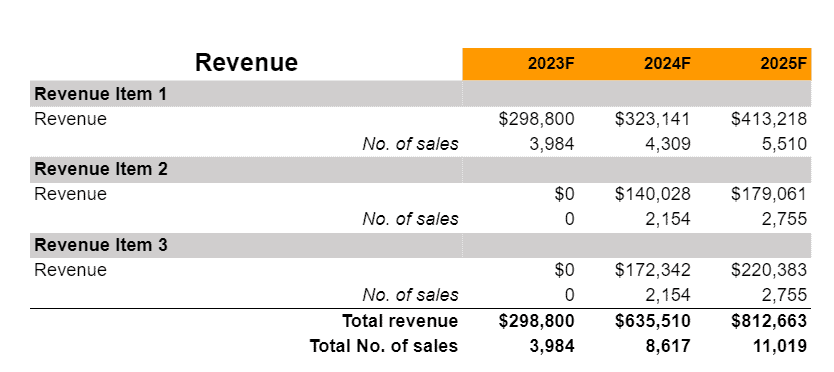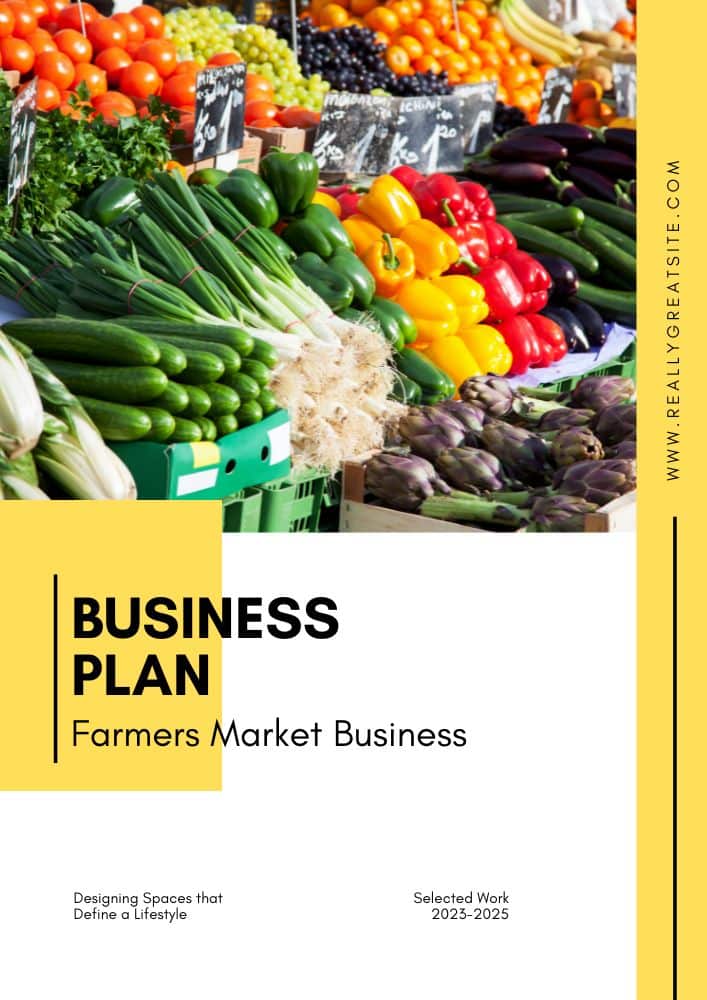Written by Elma Steven | Updated on April, 2024

How Do I Write the Farmers Market Business Plan?
Farmers Market Business Plan is an outline of your overall Farmers Market business. The business plan should includes a 5 year financial projection, marketing plan, industry analysis, organizational overview, operational overview and finally an executive summary. Remember to write your executive summary at the end as it is considered as a snapshot of the overall business plan. You need to be careful while writing the plan as you need to consider various factors that can impact the business’s success.
Executive Summary
Table of Contents
Michael Thompson established the thriving Green Bounty Farmers Market in the middle of Miami, Florida’s hectic downtown. Directly to the community we deliver the freshest most locally sourced vegetables, artisanal items and organic products at our farmers market. Our dedication to empowering local farmers and craftsmen, offering a wide variety of sustainable and organic goods and cultivating a shopping experience that is focused on the community is our USP. Among Green Bounty’s many distinguishing features are its commitment to sustainable business methods, its focus on seasonal, high-quality products and its enthusiastic inviting environment that allows customers to trace the history of their food.
Mission:
By providing a venue for regional producers and craftspeople to sell their wares we at Green Bounty Farmers Market want to strengthen the Miami community. By expanding people’s access to good, sustainably produced food we want to encourage more healthy lifestyles and less waste. Sustainability, quality and bolstering the local economy are central to our community-building efforts.
Vision:
We want to make Green Bounty Farmers Market a landmark in Miami known for its sustainability, variety and high-quality products. We want to be a gathering place for those who care about the environment those who love good food and families. Green Bounty’s long-term goal is to become a household name in Miami synonymous with healthy living, strong community ties and environmentally conscious practices.
Industry Overview:
The rising popularity of farmer’s markets as a place to buy locally produced, seasonal fruit is likely to keep going strong in the years to come. Over the next five years the farmer’s market industry in the United States is expected to expand from its current estimated yearly value of over $8 billion which is a compound annual growth rate (CAGR) of 3.5%.
Check out this guide on how to write an executive summary? If you don’t have the time to write on then you can use this custom Executive Summary Writer to save Hrs. of your precious time.
Financial Highlights
Revenue & Earnings

Source: fastercapital

Source: ibisworld
Break- Even Analysis

Investments or Fund Usage Plan

Source: farmersmarketalliance
Business Description
Business Name: Green Bounty Farmers Market
Founders:Michael Thompson
Management Team:

Legal Structure: LLC
Location: Miami
Goals & Objectives:
✔️Establish a Diverse Vendor Base: Within the first year to aim to attract a wide range of vendors, from local farmers to artisanal food producers and craft makers, creating a diverse and vibrant market.
✔️Enhance Brand and Community Recognition: Develop a strong brand identity for the market in Miami’s community through targeted marketing strategies, partnerships with local events and active social media engagement to highlight the uniqueness of the market and its offerings.
✔️Deliver a High-Quality Shopping Experience: Ensure that visitors consistently enjoy a high-quality experience with a variety of fresh locally-sourced products thereby establishing a reputation as a premier destination for quality goods.
✔️Expand Market Services and Events: To attract a larger audience and develop a community center, plan to expand the market’s services within two years. This might include holding special events, seminars or seasonal festivals.
✔️Achieve Financial Stability and Growth: Make sure the market can stay open for the long haul by achieving financial sustainability in the first three years via increasing vendor participation and consumer traffic steadily.
Services:
✔️Wide Range of Vendors: Host a diverse selection of vendors, including local farmers, artisan food producers, craft makers and organic product sellers offering customers a variety of fresh and unique products.
✔️Seasonal and Organic Produce: Focus on offering seasonal and organic produce attracting customers who prioritize health and sustainability.
✔️Artisan and Specialty Foods: Include vendors selling artisan cheeses, handmade bread, specialty condiments and other gourmet foods to cater to food enthusiasts and culinary adventurers.
✔️Local Arts and Crafts: Bring a cultural element to the market by showcasing the work of local artisans and artists and giving them a place to sell their wares.
✔️Live Music and Entertainment: Create an exciting and entertaining ambiance by hosting live music performances, cultural dances or other forms of entertainment.
Business Model Canvas
Check out 100 samples of business model canvas.

SWOT
Check out the 100 SWOT samples which will give you a better idea on SWOT writing process.

Marketing Plan
Promotional Channels
Social Media Marketing – $15,000 (30%):
✔️Utilize platforms like Instagram, Facebook and Twitter to showcase the market’s atmosphere, vendor products and customer experiences.
✔️Run targeted ads to attract local residents, food enthusiasts and eco-conscious consumers.
✔️Develop a content strategy featuring vendor stories, product highlights, customer testimonials and market day events.
Website and SEO – $10,000 (20%):
✔️Make sure your website is colorful, easy to use and full of useful information such as the market’s location, hours, vendor roster and forthcoming events.
✔️Regularly update your blog with posts on sustainable living, vendor profiles, seasonal produce guides and healthy recipes to drive organic traffic.
✔️Optimize for search engines using keywords related to farmers markets, local product and community events to improve online visibility.
Email Marketing – $5,000 (10%):
✔️Create a regular newsletter featuring market updates, seasonal offerings, special events and vendor promotions.
✔️Segment your mailing list to send tailored content to different audiences like vendors, regular customers and occasional visitors.
Local Partnerships – $7,000 (14%):
✔️Collaborate with local businesses, schools and community organizations to promote the market and create joint events or initiatives.
✔️Participate in community events and sponsor local activities to increase market visibility and community involvement.
Local Advertising and PR – $6,000 (12%):
✔️Invest in local advertising through community newspapers, radio stations and online community forums.
✔️Engage a PR firm or use press releases to announce market events, special vendor features and community initiatives.
Direct Mail and Community Outreach – $4,000 (8%):
✔️Send out flyers and brochures to local neighborhoods and businesses promoting the market and its unique offerings.
✔️Participate in community events and speak at local gatherings to build relationships and promote the market.
Referral and Loyalty Programs – $3,000 (6%):
✔️Implement a referral program rewarding customers who bring new shoppers to the market.
✔️Create a loyalty program offering discounts or special benefits to regular customers.
Additional Marketing Strategies:
✔️Vendor Spotlights: Use your platforms to spotlight different vendors each week, telling their stories and showcasing their products.
✔️Seasonal Promotions: Capitalize on seasonal produce and holidays with themed market days and special promotions.
✔️Interactive Experiences: Host cooking demonstrations, workshops and kids’ activities to make market visits more engaging and educational.
✔️Sustainability Initiatives: Emphasize your commitment to sustainability in all marketing materials aligning with the values of eco-conscious consumers.
Go To Market Strategy
Online Presence and Community Engagement:
✔️Professional Website: Create an engaging and easy-to-navigate website that highlights the market’s stalls, wares and activities. Add functionality like a blog where merchants may share their experiences, recipes that use market produce and sustainable living suggestions.
✔️Content Marketing: Post interesting articles or blog entries on a regular basis about organic farming methods, local farmers and seasonal food recommendations to attract organic visitors and keep them engaged.
✔️Local Directory Listings: Ensure your market is listed in local online directories and community portals to enhance visibility and make it easy for new customers to find you.
✔️Partnerships: Collaborate with local businesses, schools and community organizations to promote the market organize joint events or participate in community initiatives.
Seasonal Promotions and Special Events:
✔️Themed Market Days: Host special themed market days (like a harvest festival or spring celebration) to attract more visitors and create a festive atmosphere.
✔️Introductory Offers: For new vendors or on special occasions, offer promotional deals or discounts to encourage customer visits and purchases.
Digital Marketing and Customer Engagement:
✔️Social Media Campaigns: Use platforms like Facebook, Instagram and Twitter to post updates about the market, feature vendor stories and share photos of fresh produce and products.
✔️Email Marketing: Create a regular newsletter to inform subscribers about upcoming market days, new vendors and special events.
✔️Loyalty Program: Consider a loyalty program to reward regular customers such as discounts or special offers after a certain number of visits.
Brand Awareness and Community Involvement:
✔️Local Media Outreach: Reach out to local newspapers, radio stations, community blogs for features, interviews and market updates.
✔️Community Events: Actively participate in local events or sponsor community initiatives to increase the market’s visibility and underscore its community involvement.
✔️Influencer Collaborations: Partner with local food bloggers, chefs or influencers to promote the market and its vendors.
Performance Tracking and Adaptation:
✔️Customer Feedback: Post interesting articles or blog entries on a regular basis about organic farming methods, local farmers and seasonal food recommendations to attract organic visitors and keep them engaged.
✔️Analytics: Use tools like Google Analytics for your website and track social media engagement to gauge the effectiveness of your marketing strategies.
✔️Strategy Refinement: Be prepared to adjust and refine your marketing strategies based on performance data, changing market trends and community feedback.
Organizational Overview
Founder

Michael Thompson to administer the Miami farmers market are reshaping the city’s local food sector. A strong dedication to sustainable agriculture and a desire to bring people together via the shared consumption of handcrafted goods and locally produced vegetables have guided his career in the food sector.
Michael’s decision to start a farmers market is based on his deep understanding of farming and need for nutritious locally produced food. The commercial sense and community development experience to build a market that serves as more than simply a platform for selling goods it will also bring people together and teach them how to eat more sustainably.
Michael has an innate grasp of the possibilities and threats associated with connecting farmers and customers because to his years of expertise negotiating the intricacies of the local food business. He has expertly curated a lively market that serves the different tastes of Miami’s residents. In Miami, a city known for its diverse cuisine and lively community life Michael started his farmers market which is a highlight of his business adventure. Beyond providing a marketplace for agricultural goods, his business concept goes beyond that. The idea is to build a community center where people may consume food that has been sustainably farmed, talk about sustainable farming and enjoy the arts and crafts of their own area.
Positions and Responsibilities
Chief Executive Officer (CEO) :
As the CEO, you are the strategic leader of the farmers market overseeing all aspects of the business. Your responsibilities include setting the overall direction, making key business decisions, liaising with stakeholders and representing the market in public forums.
Market Manager:
The farmers market runs on a daily basis under the supervision of the Market Manager. Among these responsibilities is the oversight of vendor relations, the administration of market logistics and the enforcement of health and safety policies. Conflict resolution, scheduling and vendor selection are all responsibilities of the Market Manager.
Vendor Relations Coordinator:
This role focuses on maintaining strong relationships with current vendors and recruiting new ones. Responsibilities include vendor communications, addressing vendor concerns and ensuring a diverse and high-quality selection of products at the market.
Customer Service Representative:
To ensure that visitors have a great experience this function is crucial in handling consumer queries, comments and operating the market’s information booth. In addition, they should publicize the market’s loyalty programs and any community activities that take place.
Marketing and Promotions Coordinator:
Tasked with developing marketing strategies to promote the farmers market. This includes managing social media, creating advertising materials, engaging with the local media and organizing promotional events.
Organogram

Operational Overview
Services
Vendor Booth Spaces:
✔️Offer well-organized booth spaces for local farmers, artisans and food producers to sell their products.
✔️Provide options for different booth sizes and locations within the market.
Seasonal and Organic Product Sections:
✔️Dedicate sections of the market for seasonal produce and organic products catering to customers seeking specific types of goods.
Community-Supported Agriculture (CSA) Pickup Point:
✔️Serve as a pickup point for local CSA programs, facilitating connections between farmers and community members.
Specialty Food Events and Tasting Sessions:
✔️Organize regular food events, tasting sessions and cooking demonstrations featuring products from market vendors.
Educational Workshops and Seminars:
✔️Bring in professionals and influential members of the community to provide workshops and seminars on green living, urban gardening and nutritious food.
Industry Analysis
The global farmers market industry is a thriving and resilient market estimated to reach a value of $120 billion by 2027 growing at a CAGR of 4.5% from 2022 to 2027. This growth is driven by several factors
A rising demand for handcrafted goods and fresh locally produced vegetables is majorly altering the worldwide farmers market business. More and more people are looking for ways to support local economies eat healthily and reduce their environmental impact which has led to a surge in the popularity of farmer’s markets in many areas of the world including North America, Europe and Asia. Urbanization and the desire of city inhabitants to establish relationships with nearby farmers and producers are factors that are adding fuel to this fire.
As more people in developing nations learn about the health advantages of eating foods produced nearby this industry is also booming in emerging economies. Reasons for this change include an increasing middle class that values variety and high-quality food and worries about food safety and traceability.
Many different kinds of commodities including fresh produce, artisanal cheeses, baked foods and handmade crafts, are sold by a wide range of small-scale sellers in this business. In addition to satisfying a broad variety of tastes this variety brings people together and strengthens ties between buyers and sellers in the area.
But there are obstacles in the way of the farmers market sector such as the fact that many markets are only open for part of the year and that big supermarkets provide tough competition. In order to stay competitive a growing number of farmer’s markets are adapting by offering additional services such as online shopping and home delivery, permanent venues that are open all year and more events and seminars to bring in customers.
Line with worldwide concerns about sustainability and environmental effect there is an increasing trend towards organic products and eco-friendly techniques at farmer’s markets. More and more businesses are putting an emphasis on waste reduction providing environmentally friendly packaging and supporting organic agricultural practices.
✔️Farmers markets are in demand due to the desire for fresh, local produce.
✔️Farmers markets promote community engagement and economic revitalization.
✔️Farmers markets provide additional income streams for farmers.
✔️Farmers markets showcase sustainable agricultural practices.
✔️Farmers markets promote healthy eating habits and cultural exchange.
Industry Problems
✔️Vendor Diversity and Quality Control: Attracting a diverse group of high-quality vendors is essential. Strategies include rigorous vendor selection processes, offering incentives for unique product offerings and regularly monitoring product quality.
✔️Customer Attraction and Retention: Drawing customers consistently can be challenging. Marketing efforts should focus on the unique aspects of the market such as fresh, local produce, artisanal goods and community events. Implementing loyalty programs can also enhance customer retention.
✔️Seasonality of Products: The seasonal nature of produce can affect vendor and customer attendance. To combat this, diversify products to include non-seasonal goods like crafts, baked items or preserved foods and consider hosting indoor markets or special events during off-peak seasons.
✔️Operational Logistics and Infrastructure: Efficient management of market logistics, including vendor spaces, parking and amenities is crucial. Regularly review and adapt logistical arrangements to ensure smooth operations.
✔️Competition from Supermarkets and Online Retailers: Differentiate the farmers market with offerings not typically found in supermarkets such as organic, locally-sourced produce and handmade goods. Emphasize the benefits of supporting local agriculture and the community.
Industry Opportunities
✔️Flexible Vendor Models: Implement tiered stall pricing or offer package deals to accommodate vendors of different sizes and types, from small local growers to larger organic producers. This can make the market accessible to a wide range of vendors and ensure a diverse product offering.
✔️Efficient Stall Allocation and Scheduling: Employ an online system for stall bookings to streamline the process. Offering options for different days or seasons can accommodate vendors’ varying schedules and product availability, optimizing market space and variety throughout the year.
✔️Quality Control and Product Diversity: Regularly monitor and maintain high standards for product quality. Encourage vendors to offer a diverse range of products including unique and artisanal items to attract a broad customer base.
✔️Community Engagement and Marketing: Foster a strong community presence through targeted marketing, social media campaigns and partnerships with local businesses and organizations. Host special events, workshops and educational programs to enhance the market’s appeal and draw in more visitors.
✔️Convenient Location and Accessibility: Choose a market location that is easily accessible by public transportation and has ample parking. Consider the needs of different customer groups including families and elderly visitors to ensure a comfortable and inclusive environment.
Target Market Segmentation
Geographic Segmentation
✔️Target Specific Miami Areas: Tailor offerings based on the unique characteristics of different neighborhoods. For instance, areas with higher foot traffic might appreciate quick grab-and-go items while residential areas may focus more on fresh produce for home cooking.
Demographic Segmentation:
✔️Age Groups: Offer products that cater to different age groups. Younger demographics might be drawn to trendy, health-conscious products while older demographics might appreciate traditional goods.
✔️Income Levels: Provide a range of options from affordable basic produce to more premium artisanal products to cater to varied income levels.
Psychographic Segmentation:
✔️Health and Wellness Enthusiasts: Stock organic, non-GMO or locally-sourced produce and products to attract health-conscious customers.
✔️Eco-Conscious Shoppers: Focus on sustainable and eco-friendly products including packaging to appeal to environmentally aware consumers.
✔️Foodies and Gourmet Shoppers: Offer gourmet food items, exotic produce and unique culinary experiences for food enthusiasts.
Behavioral Segmentation:
✔️Regular Shoppers: Encourage regular visits through loyalty programs or weekly specials.
✔️Occasional Visitors: Attract tourists or occasional visitors with unique local products that serve as souvenirs or gifts.
✔️Event-Driven Shoppers: Cater to those attending the market for specific events like seasonal festivals or cooking demonstrations.
Technological Segmentation:
✔️Tech-Savvy Consumers: Implement an online presence for the market, offering pre-orders, digital maps of vendor locations or an app for easy navigation and updates.
✔️Traditional Shoppers: Maintain a user-friendly environment with clear signage and information booths for those who prefer a traditional shopping experience.
Market Size
✔️Total Addressable Market (TAM) for Farmer’s Market Business: Your farmer’s market business’s Total Addressable Market consists of all the people in your local, state or federal market who have the ability to buy farm-fresh vegetables, handmade goods and other items offered at farmer’s markets. Customers in this large market range from individuals to restaurants and other establishments that value using items that are fresh and made in the area. Organic produce is becoming more popular, sustainable food sources are becoming more popular and there is a general movement towards healthy eating habits, all of which impact the size of the TAM for your firm. If you want to know how big the farmer’s market industry is and how much room there is for expansion, you should study up on the TAM.
✔️Serviceable Addressable Market (SAM) for Farmer’s Market Business: In contrast to the TAM, the Serviceable Addressable Market (SAM) at your farmer’s market is narrower in scope. This number signifies the percentage of the market that your company can really cater to. Your SAM is defined by a number of factors such as the precise demographics of the customers you want to attract, the variety, quality of items you provide and the location of your market. A farmer’s market that sells mostly organic and handcrafted items would have a different SAM than one that sells a larger variety of standard goods. Depending on your business’s location and the specifics of your farmer’s market this segmentation might help you zero in on the ideal clientele.
✔️Serviceable Obtainable Market (SOM) for Farmer’s Market Business: You may reasonably anticipate capturing the Serviceable Obtainable Market (SOM) for your farmer’s market. Given your existing skills, competition and market placement this measure indicates the real market share you may hope to acquire making it a critical indicator. Your SOM is affected by a number of factors including as how accessible and popular your market is the variety and quality of your items, the success of your marketing, community involvement initiatives and the general satisfaction of your market’s customers. You may make better choices about marketing, vendor connections and customer service activities with the help of the SOM which provides a more concrete goal for sales and growth.
Industry Forces
Market Demand and Industry Trends
✔️Consumer Preferences: Growing trends toward organic, locally-sourced and artisanal food products shape the demand in the farmer’s market sector.
✔️Health and Wellness Focus: Increased consumer awareness around health, wellness and sustainable eating habits can drive more traffic to farmer’s markets.
Competition
✔️Diverse Market Landscape: Competition includes other local farmer’s markets, grocery stores and online fresh produce platforms. Differentiating your market through unique vendor offerings, exceptional produce quality or a focus on organic and sustainable products can help you stand out.
✔️Local vs. Wider Market Reach: Positioning in the local community versus a broader geographic area needs distinct strategies, from local community engagement to wider digital marketing efforts.
Technological Advances
✔️Digital Marketing and Sales Platforms: Utilizing social media and an online presence to promote the market and its vendors can attract a larger customer base.
✔️Point of Sale Technology: Implementing modern payment solutions can enhance the customer experience and streamline transactions.
Regulatory Environment
✔️Food Safety and Vendor Compliance: Ensuring all vendors comply with local food safety and handling regulations is crucial.
✔️Permitting and Zoning Laws: Navigating local permitting and zoning laws is essential for operating your farmer’s market.
Economic Factors
✔️Pricing Strategies: Economic conditions including consumer spending power can influence pricing strategies. Offering a range of products at various price points can cater to different customer segments.
✔️Operational Costs Management: Managing operational costs such as vendor fees and market maintenance is key to maintaining profitability.
Financial Statements
The financial model has all the important financial statements including Income Statement, Balance Sheet and Cash Flow Statement. In addition, the financial model includes 3 to 5 years of projections and can be edited using Microsoft Excel or Google Sheets.
Income Statement
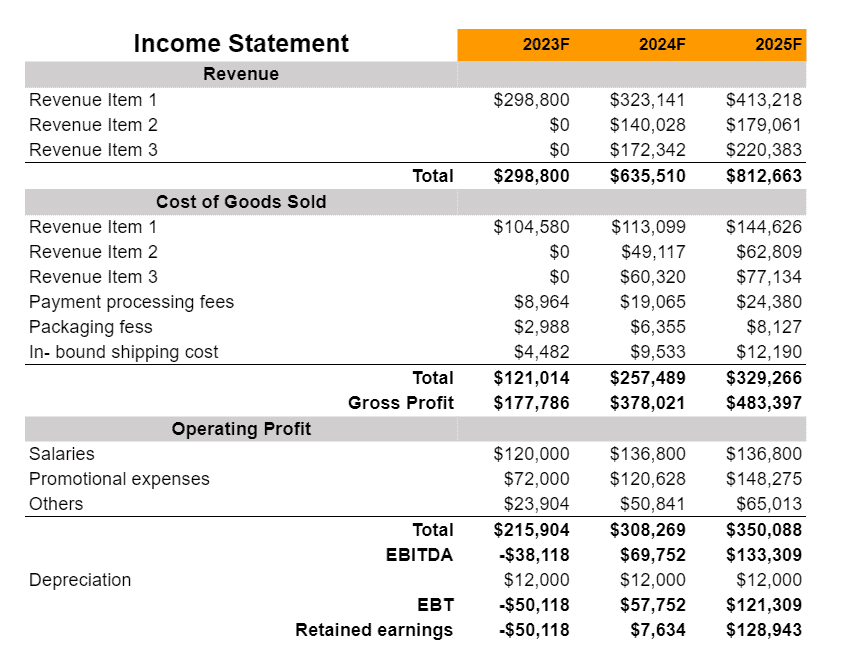
Cash Flow Statement
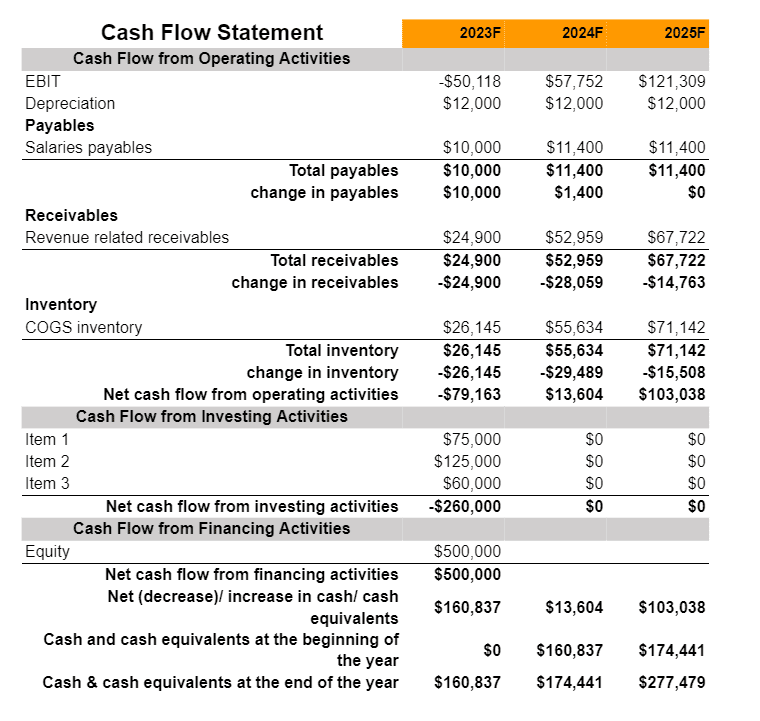
Balance Sheet
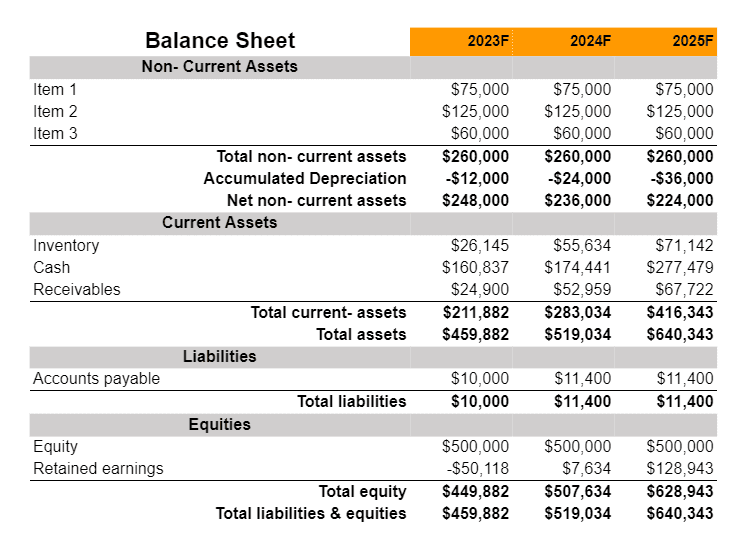
Revenue Summary
